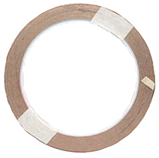
To keep track of your sizes be sure and write the sizes down with a magic marker (thin), on each side of the foil, along with the inner ring. At this time it might be a good idea to also put the date of when you opened the foil too, so you'll always know about how old it is.
When foiling the glass, make sure the glass is completely free of dust and oils. Clean the glass with soap and water if you have to , and make sure the piece is completely dry. Sometimes a tiny bubble in the edge of the glass traps water. When you try to dry it, it always to seems to be wet there. Make sure that the glass is either ground (for better adhesion) or is at least very smooth. Try not to handle the glass too much or the foil. When I foil, I always wrap the whole thing. Then I put extra pressure on the edge first, then pinch and rub. Try to give yourself an overlap of around 1/4" to 1/2". I've seen people try to cut the foil to make a butt joint, but that almost always leaves either a weak spot or a non-foiled spot. Also, try to start the foil on the inside edge of the piece, so there's no chance of the foil lifting from that.
Warm glass is always easier to foil than cold, here's some ways to warm it up:
Foiling blobs are always a pain to do. The large ones are OK, but the smaller ones are a real pain in the neck. The first thing I always do is to lightly grind the blob. Most people don't think of this because the blob is very smooth. But it's a good idea because it will allow the foil to have a better bite and it also shows you where to center the foil. Make sure to really wash the blob good before foiling. When I wrap a large blob, I do it as any other piece of glass. After pinching though, I found it's easiest to hold my fid (or rubbing stick) like I was peeling an orange. With a thumb up on the blob for more leverage, be sure and crimp the foil nice and smooth. With 3/16" foil it is possible to get a perfect crimp job on a large blob. For smaller blobs, do the same as above, only after you crimp the foil with your hands, put the foiled blobs into a container about 1/2 full of small blobs, and shake. It will be pretty darn noisy, but it works really well.
When foiling small pieces (anything 1/2" x 1/2" or so) I rarely rub the piece. Generally after pinching, I push the piece of glass into a plastic board, knocking down the sharp foil corners. In fact I do this to all my pieces before rubbing them down. To get even a tighter foil, (this works best on straight pieces), get a small seam roller (the kind you use for wall paper). This helps squish the foil into place.
Foiling inside curves can be difficult usually what happens is that the foil either folds or rips when you try to pinch or rub it down. This is what you do:
When foiling a real lumpy glass like drapery, ripple, antique, etc. try to use a wider foil when possible. Ripple glass takes forever to foil. This is because of all the indents you have to push the foil into. When you have to rub down this kind of glass, start with the edges, then do the surface of the glass. When I rub normal glass, I always start with the surface for some reason.
To rub down the foil, you'll need to use a stick of some sort. A pencil would be a good choice but the graphite tends to get in the way. I've bought quite a few shapes of fids (a type of rubbing stick) but they all wear out pretty quickly. So I designed my own fid, (BTW although a fid is normally used to open up a lead came channel, I'm using it in the context of rubbing foiled projects). This is how I made my own fid:


Back to Tips and Observations Index
Home | About Me | Aliens | Foil | Miscellaneous | Shop | Projects | Shopping List | Links | Awards

Started on 9-22-98